Specialized Keyboards
The last category of keyboards is specialized keyboards. Some people prefer to call them strange keyboards ”and some of them are indeed strange. But if your work (or play) involves a lot of typing, a specialized keyboard can save you plenty of time, effort, and grief .
Dividing specialized keyboards into categories tends to be difficult, because there are many different types of keyboards. But here s a stab at division:
-
Undersized and oversized keyboards
-
Keyboards with integrated pointing devices
-
Split keyboards
-
Split and tilted keyboards
-
Superergonomic keyboards
-
One-handed keyboards
If you re in the market for a specialized keyboard, you may find that the essential division is between keyboards that use a modified version of the standard keyboard layout and keyboards that use a radically different layout. Keyboards that use a modified version of a standard layout are usually easy to get started with, because you don t have to learn entirely new typing habits. Keyboards that use radically different layouts can offer greater ergonomic benefits or ease of use, but you ll have to learn to type on them, which can involve a considerable learning curve.
If you use the same keyboard for all your data entry, learning a new keyboard layout may be sensible and easy. If you need to use various computers, you ll probably be better off using a specialized keyboard that modifies the standard keyboard layout.
Specialized keyboards start at several hundred dollars and progress to more than a thousand, making them a serious investment. But if you re starting to suffer from RSI ”or attempting to avoid it altogether ”the investment may well make sense.
Undersized and Oversized Keyboards
The first type of specialized keyboard you may want is an undersized or oversized keyboard. Generally speaking, there are two types of undersized keyboards: space- saving keyboards designed for small working surfaces, and keyboards with smaller- than-usual keys for people with small hands. If you look hard enough, you can find space-saving keyboards that use smaller-than-usual keys as well.
If your desk or other working surface is short of space, a compact keyboard may be the answer. Some compact keyboards have no numeric keypad, while others have an embedded numeric keypad like those many notebooks have. If space is at a premium, consider a compact keyboard that has an integrated pointing device, such as a pointing stick, a trackball , or a touchpad. Because the pointing stick is usually located among the keys rather than requiring an area of its own, keyboards with pointing sticks tend to be the most compact solution available.
As you learned earlier in this appendix, standard key spacing for a keyboard is 19 mm from the middle of one key to the middle of the next key. If you ve learned to type on a keyboard with this key spacing, and your hands aren t extra small or extra large, you ll probably find it comfortable enough. But if your hands are extra small, you may be better off with a keyboard that has smaller-than-usual key spacing. A couple of millimeters makes a considerable difference: 17 mm spacing (which you ll find on various ultraportable laptops) is manageable for most people, but 16 mm feels very cramped. At 15 mm and smaller sizes, anyone with normal- size fingertips has to type very accurately so as not to strike one or more neighboring keys by mistake. (If you ve ever handled one of the Toshiba Libretto micro-notebooks, that s 15 mm keyboard spacing.)
Undersized keyboards are relatively easy to find if you search on the Web; so are oversized keyboards ”at least, keyboards with hugely oversized keys, not the fractionally larger keys (say, 20 mm or 21 mm spacing) that people with large hands might find useful. A typical oversized keyboard, such as the Big Keys Keyboard (available from various sources), has keys that are one-inch square, which is four times the size of standard keys on a typical desktop keyboard. Keys this large aren t much good for touch-typing unless you have giant hands, but they re great for industrial environments (gloved fingers) and for mild disabilities (a bigger key is easier to strike without blipping another key). Large keys can also be good for children, because the letters are easier to spot; and some models come with the keys in a variety of colors.
Keyboards with Integrated Pointing Devices
As you read in the previous section, some undersized keyboards include integrated pointing devices. Some full-size keyboards have them as well. Most of these pointing devices are pointing sticks, touchpads , or miniature trackballs, but if you search, you can also find keyboards with more esoteric pointing devices.
Some of the stranger keyboard types include advanced pointing devices. For example, the TouchStream keyboards from FingerWorks ( www.fingerworks.com ) include a custom pointing device that interprets the gestures from your hands.
Split Keyboards
Standard keyboards have been blamed for causing carpal tunnel syndrome by forcing users to hold their hands (or even wrists) parallel to each other. In fact, this supposed compulsion is largely imaginary: it s actually easier to type with your hands pointing inwards at a natural angle even on a regular keyboard.
Even so, many users find split keyboards more comfortable than regular keyboards. In a split keyboard layout, the keys assigned to the right hand are physically separated from the keys assigned to the left hand, often by several inches, to provide easier positions for the hands and arms.
If you learned to type with the correct fingers, you should have no problems with the division of the keyboard. If you learned bad habits such as reaching over for [B] with your right forefinger, you ll need to unlearn such habits before you can use a split keyboard easily.
The Microsoft Natural Keyboard is perhaps the best known and most widely used split keyboard, but there are many others. More expensive and more ergonomic models, such as the Maltron keyboard and the Kinesis Advantage keyboard (shown in Figure A-1), use a well for each hand to put the fingers in a more comfortable typing position.
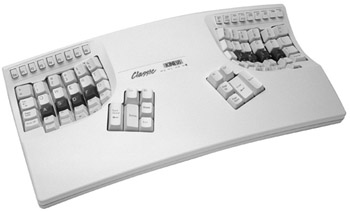
Figure A-1: An example of a split keyboard: the Kinesis Advantage keyboard
Split and Tilted Keyboards
Splitting the keys puts the hands and forearms into a more comfortable position, but both hands are still fully pronated (pointing downward). The next move on the ergonomic scale is to put the hands in a more neutral position by tilting the halves of the split keyboard away from each other. Various models of split and tilted keyboards are available, but one of the most popular is the Maxim keyboard (shown at the top in Figure A-2) from Kinesis ( www.kinesis-ergo.com ). A more extreme split keyboard (and arguably a superergonomic keyboard) is the SafeType Ergonomic Keyboard (shown at the bottom in Figure A-2) from SafeType( www.safetype.com ).
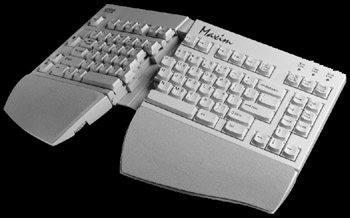
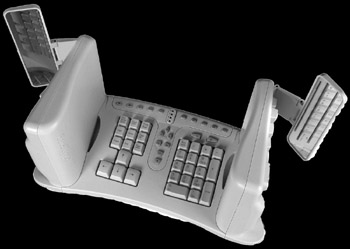
Figure A-2: Split and tilted keyboards like the Maxim keyboard from Kinesis (top) and the SafeType Ergonomic Keyboard (bottom) from SafeType put the hands and forearms in a more neutral and comfortable position than flat keyboards.
Superergonomic Keyboards
At this point, we move into the sphere of what you might term superergonomic keyboards. Here, things get either truly interesting or truly strange, depending on your perspective. This section presents samples of the types of keyboards you may want to examine if you need to improve your ergonomics beyond the point that split keyboards and split and tilted keyboards can deliver.
Superergonomic keyboards tackle the problem of repetitive keystrokes causing RSI in different ways: by using zero-force keys, by using different types of keys, or by not using keys at all.
FingerWorks TouchStream
The TouchStream keyboards from FingerWorks ( www.fingerworks.com ) include a custom pointing device that interprets the gestures from your hands. The TouchStream keyboards (Figure A-3 shows an example) are hard to comprehend without actually laying your hands on them and seeing what they do, but the combination of hardware and software is pretty amazing. For example, you click by tapping once with any two fingers together, and double-click by tapping once with any three fingers together. The keys themselves use what FingerWorks calls zero-force ”you do press them, but with minimal force.

Figure A-3: The TouchStream keyboard from FingerWorks integrates mouse and gesture support in a zero-force keyboard.
DataHand Ergonomic Keyboard
The DataHand Ergonomic Keyboard (Figure A-4) from DataHand Systems ( www.datahand.com ) is a radically different type of keyboard. In the DataHand, each finger occupies its own well, a hole that consists of five keys: a round button to press down (as in a standard typing motion), surrounded by four curved buttons , each of which you press outwards. Each thumb controls six key switches, and the keyboard supports three modes, giving the equivalent of all the keys in a regular keyboard and more.

Figure A-4: The DataHand Ergonomic Keyboard is strange looking and expensive, but its devotees swear by it.
The DataHand is available in different hand sizes and costs from $975 to $1,275 at this writing, depending on whether you go for a personal model or a programmable professional model. Its cost puts the DataHand out of the reach of most consumers; however, if your job involves huge amounts of data entry, and your company is forward-thinking enough to actively avoid repetitive-stress injury problems, and you ve been exercising your powers of persuasion, the DataHand might seem a viable choice.
orbiTouch Keyless Keyboard
The TouchStream and DataHand keyboards have different approaches to reducing the keypresses that cause repetitive-stress problems. But if pressing the keys is the problem, clearly the solution is to get rid of the keys altogether.
You might think getting rid of the keys is a joke, but the orbiTouch Keyless Keyboard from Keybowl ( www.keybowl.com ) does just that. The orbiTouch (Figure A-5) is built around two domes that you move with your hands. Each of the domes slides to eight positions like the eight points of the compass. You type a letter by sliding the domes to the combination of their positions that represents that character. For example, to type a T, you slide the left dome to its North position and the right dome to its East position. To type an H, you slide the left dome to its East position and the right dome to its West position. The orbiTouch has an integrated mouse, so you can keep your hands on the domes the whole time.
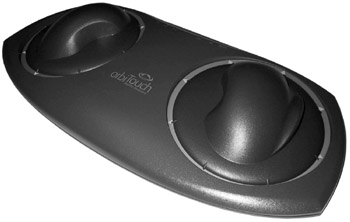
Figure A-5: Instead of keys, the orbiTouch Keyless Keyboard has two domes, each of which you slide to any of eight positions.
One-Handed Keyboards
Last in our tour of specialized keyboards come one-handed keyboard models. There are two main types of one-handed keyboards: those designed to be used on the desktop or a similar stationary surface, and those designed to be held in the hand. Not surprisingly, given how most computers are used, the former category has more occupants than the latter.
Most one-handed desktop keyboards are designed for people suffering from a permanent or temporary disability that prevents them from using both hands. For example, P.C.D. Maltron ( www.maltron.com ) makes single-handed versions of its ergonomic keyboards.
The FrogPad (shown next) from the company of the same name ( www.frogpad.com ) is an ultracompact one-handed keyboard designed for right-handed use. FrogPad has a left-handed model in the works. Unlike the Maltron single-handed keyboards, the FrogPad is primarily intended for portable and wearable computers, although it works fine with any computer that accepts USB input. Because the FrogPad has only 20 keys, you enter the less used letters, punctuation, and symbols by chording (holding down a key while you press another key). For example, to enter an L, you hold down [Spacebar] and press [H] . The FrogPad also supports separate modes for entering numbers and symbols. The keyboard is well thought out and comfortable to use, but learning the letter positions and the chords takes considerable effort.
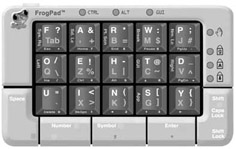
The Twiddler from Handykey ( www.handykey.com ) is a handheld chording keyboard with a built-in pointing stick. The Twiddler works with either hand and connects to any computer that accepts Host USB, which makes it suitable for both desktop and handheld use. Strapped to your hand, the Twiddler feels very strange at first, and the learning curve feels precipitous. But if you put in the effort, you can get up to a decent typing speed (more than 50 words per minute) on a keyboard that you can use anywhere you have a hand free.
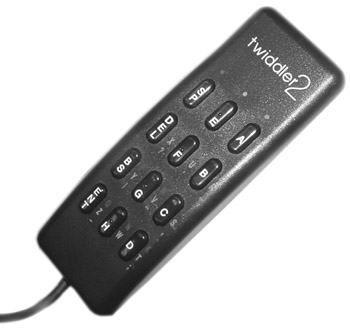
EAN: 2147483647
Pages: 117